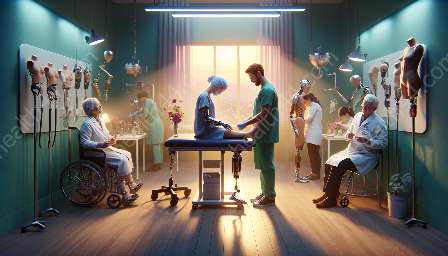Artificial organs, prosthetic devices, and medical equipment have revolutionized the healthcare industry, offering innovative solutions to improve patients' quality of life. From artificial hearts to advanced prosthetic limbs, the development of these technologies continues to push the boundaries of medical innovation.
The Rise of Artificial Organs:
Artificial organs, also known as implantable or bioengineered organs, have emerged as a groundbreaking solution for patients suffering from organ failure. These devices are designed to replicate the functions of natural organs, offering a lifeline to individuals in need of transplants. The development of artificial organs has significantly reduced the dependency on organ donors and waiting lists, providing hope for patients with end-stage organ failure.
Types of Artificial Organs:
There are various types of artificial organs that have been developed to address different medical needs:
- Artificial Hearts: The creation of artificial hearts has been a remarkable achievement in medical technology. These devices are designed to replace damaged or failing hearts, providing a bridge to transplant or serving as a permanent solution. Artificial hearts have significantly improved the survival rate and quality of life for patients with severe heart conditions.
- Artificial Kidneys: For patients with kidney failure, artificial kidneys offer a life-saving alternative to traditional dialysis or organ transplant. These devices use advanced filtration and reabsorption techniques to mimic the functions of natural kidneys, allowing patients to lead more normal lives.
- Artificial Lungs: Designed to assist patients with respiratory failure, artificial lungs provide vital oxygenation and carbon dioxide removal. These devices are particularly beneficial for individuals awaiting lung transplants or those who are not suitable candidates for traditional transplantation.
- Artificial Pancreas: Individuals with diabetes have benefited from the development of artificial pancreas systems that automate the monitoring and delivery of insulin, mimicking the functions of a healthy pancreas. These devices have transformed the management of diabetes, offering more precise control over blood sugar levels.
Advancements in Prosthetic Devices:
Prosthetic devices have played a crucial role in restoring mobility and functionality for individuals who have lost limbs due to injury, disease, or congenital conditions. The evolution of prosthetics has brought about significant improvements in design, materials, and functionality, allowing amputees to lead active and fulfilling lives.
Types of Prosthetic Devices:
There are several types of prosthetic devices that cater to different levels of limb loss and functional needs:
- Lower Limb Prosthetics: Advances in lower limb prosthetics have resulted in the development of highly responsive and adaptive devices, such as bionic legs and computer-controlled knees. These prosthetics enable individuals to walk, run, and engage in various physical activities with greater ease and stability.
- Upper Limb Prosthetics: The field of upper limb prosthetics has witnessed remarkable advancements, with the creation of myoelectric prosthetic arms and hands that respond to muscle signals, allowing users to perform intricate tasks and grasp objects with precision.
- Cosmetic Prostheses: In addition to functional prosthetic devices, there are cosmetic prostheses that are intricately designed to replicate the appearance of natural limbs, providing a sense of normalcy and confidence for individuals who opt for non-functional prosthetic solutions.
Technological Innovations in Medical Equipment:
Medical devices and equipment continue to evolve with the integration of cutting-edge technologies, enhancing diagnostic accuracy, treatment efficacy, and patient care. These advancements have redefined medical practices and empowered healthcare professionals to deliver more personalized and effective treatments.
Noteworthy Medical Equipment Innovations:
Several medical devices and equipment have revolutionized healthcare delivery and patient outcomes:
- Robotic Surgery Systems: The advent of robotic-assisted surgery has enabled surgeons to perform minimally invasive procedures with unprecedented precision and dexterity, resulting in reduced trauma, faster recovery, and improved surgical outcomes.
- Implantable Medical Devices: Implantable devices, such as pacemakers, defibrillators, and neurostimulators, have significantly improved the management of cardiac and neurological conditions, providing patients with long-term therapeutic support and monitoring.
- Diagnostic Imaging Technology: The evolution of diagnostic imaging modalities, including MRI, CT, and PET scans, has vastly improved the detection and characterization of diseases, guiding more accurate treatment planning and monitoring of therapeutic responses.
- Remote Patient Monitoring: With the integration of telemedicine and wearable devices, healthcare providers can remotely monitor patients' vital signs, medication adherence, and disease progression, enhancing the continuity of care and enabling early intervention.
The Future of Medical Technology: Integration and Collaboration
The convergence of artificial organs, prosthetic devices, and advanced medical equipment presents a promising future for healthcare. The seamless integration of these technologies, coupled with ongoing research and collaboration, holds the potential to further enhance patient outcomes, redefine treatment paradigms, and improve overall healthcare delivery.


